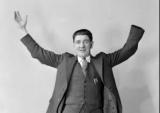What happened that day?
See historic events for any day of the year by entering the date below. Why not try your birthday?
Kiwi of the Week
Today in History

1847 Wakefield and Featherston duel
Dr Isaac Featherston, the editor of the Wellington Independent, strongly attacked the New Zealand Company’s land policy in his newspaper’s 24 March 1847 issue. Colonel William Wakefield, the Company’s Principal Agent in New Zealand, interpreted this editorial as a thinly disguised accusation that he was a thief. In the resulting duel, held at Te Aro, Wellington, Featherston fired first and missed. Wakefield then fired into the air, commenting that he ‘would not shoot a man who had seven daughters’. Duelling was going out of favour as a means for upper-class men to reclaim their injured honour; this seems to have been the last duel fought in Wellington.
Featherston had arrived at Wellington in May 1841 as surgeon superintendent on board the New Zealand Company ship Olympus. He practiced medicine in Wellington and was heavily involved in local affairs. In 1853 he would be elected unopposed as the first superintendent of Wellington province.
After becoming the first editor of the Wellington Independent in 1845, Featherston used the paper to attack the New Zealand Company for deceiving migrants. He had himself been bitterly disappointed on arrival in Wellington: ‘Did those mud hovels scattered along the beach, or those wooden huts which appeared every here and there … represent the City of Wellington?’ Where, he asked, were the hundreds of acres of ‘fine fertile land which shall produce such astounding crops?’ His own investment was no more than ‘a useless swamp worth nothing’. William Wakefield, the Company’s main representative in Wellington, bore the brunt of his complaints.
Internal links

1940 John A. Lee expelled from Labour Party
A charismatic ex-soldier, orator and writer, John A. Lee had been active in the New Zealand Labour Party since shortly after the First World War. Following Labour’s landslide victory in 1935, he fully expected to be in Cabinet. But Prime Minister M.J. Savage no longer liked or trusted Lee, with whom he had clashed over both policy and tactics. Lee believed Savage was unnecessarily cautious; Savage thought Lee was too wild and unconventional.
In 1936 Lee was made a parliamentary under-secretary with responsibility for Labour’s state housing scheme. By March 1939 some 3440 houses had been completed. The success of the programme owed much to Lee’s enthusiasm and organisational ability.
Lee remained dissatisfied with the government’s caution on economic issues. He also opposed what he saw as a lack of democracy within caucus. He and his supporters won a vote in caucus to elect the Cabinet directly, but Savage refused to accept this.
In 1938 Lee won the largest electorate majority in New Zealand history, but Savage appointed Tim Armstrong as minister in charge of housing. Lee responded by writing to all members of Labour’s caucus spelling out his criticisms of finance minister Walter Nash and detailing disputes within caucus. Lee was censured at the party’s 1939 conference, with little effect. He went too far – even for some of his supporters – when he wrote an essay that questioned Savage’s mental capacity to govern. The prime minister was dying of cancer and the party quickly turned this into an issue of loyalty. Preparations were begun to have Lee expelled at the 1940 conference.
By the time of the conference in March, Savage had recovered sufficiently to pen an addition to his report. He accused Lee of having made his life ‘a living hell’ for the past two years. Although his supporters maintained that the real issue was party democracy, Lee was expelled by 546 votes to 344. Savage died two days later.




















